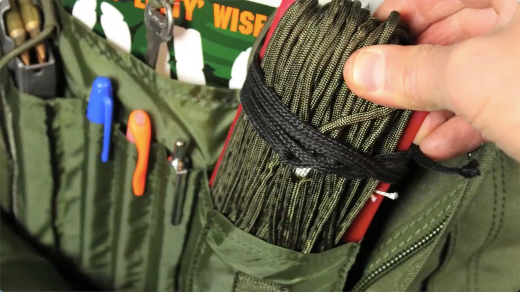Paracord in Survival: Why is Paracord So Important & How Can it Save Your Life?

People ask me all the time why they should use paracord instead of more affordable plain nylon cord.
This is a great question because on the surface, we really don’t see much of a difference between the two. They’re both cord, about the same diameter and weight. And one is half the cost of the other.
So What's the Big Deal About Paracord Anyway? And why should you even care if you use paracord or just plain nylon cordage in your Bug Out Bag, emergency kit or on your next camping trip?
The answer is simple... Paracord (short for parachute cord) gives you many more options for improvising in a survival situation.
Let  me explain... Take a look at standard 150lb test weight nylon cord, next to a length of Type III commercial grade, 550 parachute cord.
me explain... Take a look at standard 150lb test weight nylon cord, next to a length of Type III commercial grade, 550 parachute cord.
The 550 means that the paracord is rated with a minimum breaking strength of 550 pounds or about 250 kilograms. Let me point out that this stuff is strong, but it’s not rated for climbing or things like that. So just in its load-bearing strength, we already we know that our Type III 550 paracord is over 3 times stronger than the nylon cord... and alone, this is enough for me...
But That’s Not All... The real genius of the parachute cord, is how it’s engineered with an outer casing and ours has 7 internal yarns. Each yarn in OUR paracord is made of 2 individual strands. NOTE: We use high quality, U.S. Made commercial grade Type III 550 paracord that has 7 yarns and 2 strands per yarn.
However, Genuine MIL-SPEC MIL-C-5040 Type III Paracord has 7-9 yarns and 3 strands per yarn. The problem is that Mil Spec paracord can be expensive and hard to find. So for our purposes and budget the U.S. made, commercial grade 550 paracord we use is fine. However, if you plan on jumping out of a plane, I suggest you use Genuine MIL-SPEC MIL-C-5040 Type III Paracord :) This design prevents the cord from totally failing if it’s nicked or damaged slightly... because even if the casing and a few yarns are harmed, we should still have several independent yarns and strands keeping this thing together. But strength and resistance to damage are not the only beautiful things about having paracord in a survival situation...
Check This Out... So 1 foot or 30 centimeters of paracord is actually 8 feet or about 2.4 meters of usable cordage when you pull it apart. This means that 100 feet or 30 meters of paracord... that weighs only around 6 ounces or 170 grams... gives you up to 800 feet or 243 meters (well over two soccer or American Football fields) of strong usable cord when you pull it apart. How cool is that? So you simply pull the casing off...  And now you have this rugged outer casing that has many uses alone... including: making a great boot lace, a tie down and thousands of other uses... AND there are 7 pretty tough individual YARNS inside that are often called the guts... These tough little guys are suitable for sewing, a fishing line, net making, shelter building, bushcraft, snares and traps, and any other use you can dream up when you need to improvise to stay alive.
And now you have this rugged outer casing that has many uses alone... including: making a great boot lace, a tie down and thousands of other uses... AND there are 7 pretty tough individual YARNS inside that are often called the guts... These tough little guys are suitable for sewing, a fishing line, net making, shelter building, bushcraft, snares and traps, and any other use you can dream up when you need to improvise to stay alive. 


So we’ve just taken a look at some paracord basics and why paracord is ofter better than other cordage options.




Leave a comment